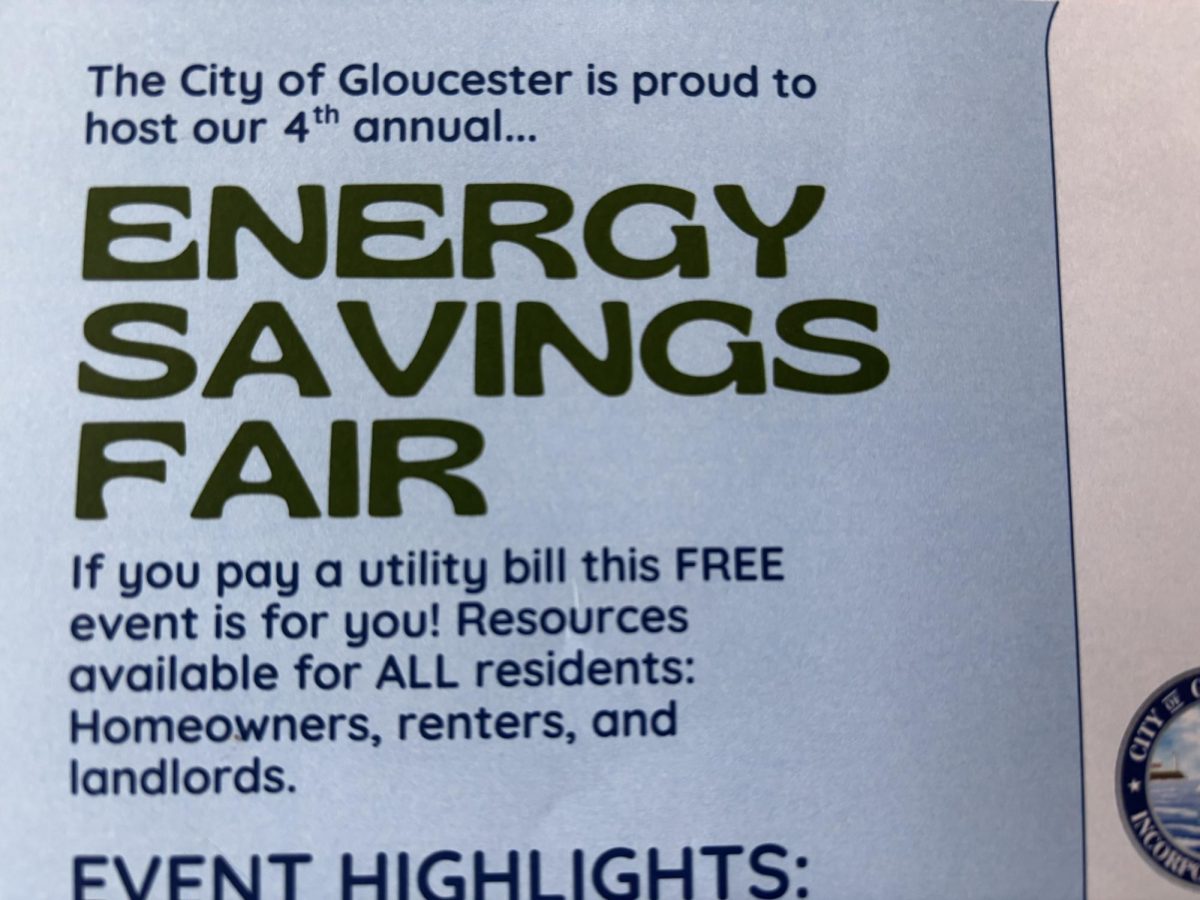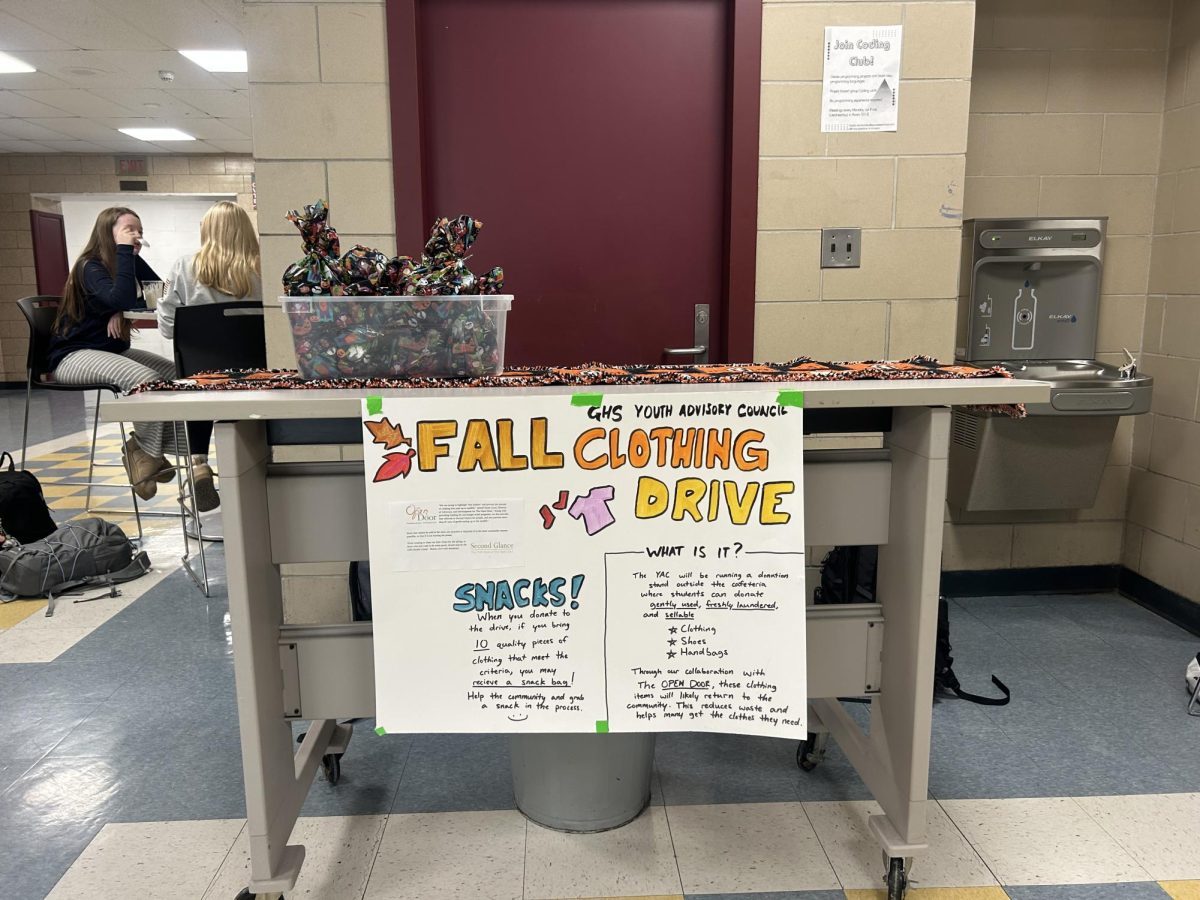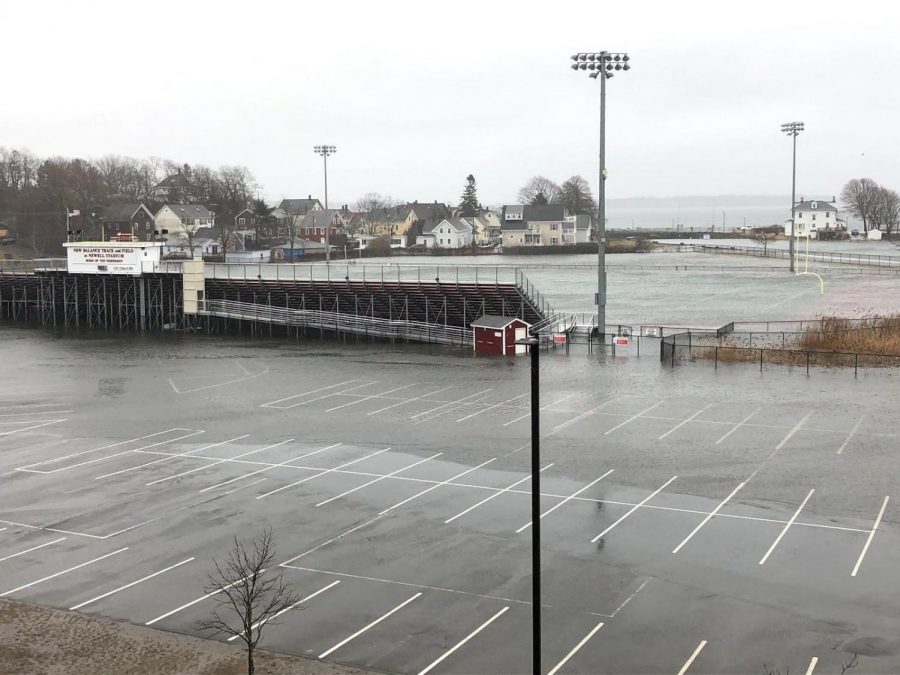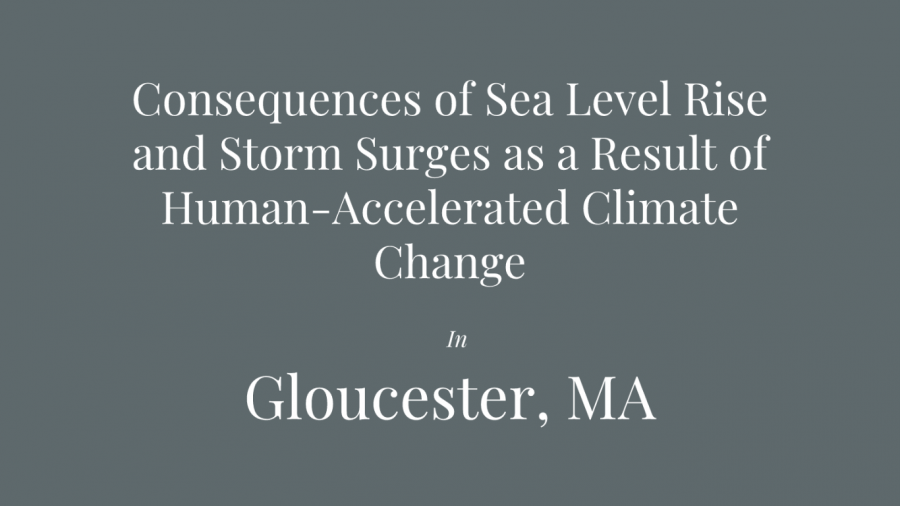GHS will continue to flood due to sea level rise, climate change
April 11, 2018
Gloucester High School’s student parking lot and New Balance Newell Stadium — along with other main roadways, homes, and businesses in Gloucester — have flooded twice this winter. According to the GHS Environmental Issues and Ecology classes, this is not a result of sporadic weather patterns.
“In light of recent evidence, rapid climate change has tremendously increased the potential for damage from storm surges and sea level rise,” said the classes in a presentation they gave to community members on March 23rd.
“With that being said, numerous homes, social, cultural and historical areas, businesses and crucial roadways are in danger of total destruction in the Gloucester area,” the students continued.
Parts of Gloucester that will be affected by sea level rise
All the information in this section is summarized from the Environmental Issues and Ecology classes’ sea level rise presentation, which can be viewed below the story.
1.) The Causeway/Mobil/Sewage Treatment Plant
The Causeway and Mobil gas station flooded twice this winter. This caused significant damage to the roadways there, as people could not travel through that area of Gloucester during and even after the storm had concluded.
Although it hasn’t flooded yet, the Sewage Treatment Plant’s location there could pose severe problems in the future. If sea water floods the plant, it could carry waste into the surrounding area and contaminate anything that touches it.
2.) Good Harbor Beach/Backshore
The footbridge at Good Harbor could be damaged again or swept away entirely. More flooding during astronomically high tides could submerge streets and buildings. Pollution and contamination could be transferred from land into the ocean, and vice versa.
3.) Richdales/Captain Hooks
Richdales and Captain Hooks, which are not far from O’Maley Middle School, have a high risk of flooding due to the rising sea level.
During the last storm, the convenience store flooded, as did other businesses and roads. If sea levels continue to rise and the area permanently floods, people won’t be able to commute through this area and the homes there will be affected.
4.) Wingaersheek and Route 128
Route 128 is one of two exits off of the island. When the storms occur, the water levels can rise high enough to reach Lobsta Land and Sudbay Dealerships, and even cover the highway itself.
How climate change drives sea level rise and more severe storm surges
Since the Industrial Revolution, the increasing amounts of greenhouse gases, such as CO2 and methane, that humans have pumped into the atmosphere have caused the earth’s temperature to rise at a significant rate.
“These gases have trapped heat from the sun in the Earth’s atmosphere and caused the overall temperature to rise more than 1° F in just the last century alone,” said the Intergovernmental Panel on Climate Change.
The Earth’s rising temperature is melting glaciers, which in turn is releasing more water into the ocean. It has also led to thermal-expansion, or when water particles get warmer, which leads to the ocean getting bigger.
Human action has also contributed to the ocean’s expansion. Irrigation systems that bring groundwater up to the earth’s surface add more water to the water cycle, which means more rainwater will be released into the ocean.
The introduction of more fresh water into the ocean is also harming important currents. Currents that run deep in the ocean bring otherwise unreachable nutrients to the surface. These nutrients allow algae and other organisms to grow and act as the foundation of many ecosystems.
These currents are able to run so deep in the ocean because of the high density of cold, salty water. But if the ocean continues to become warmer and less salty due to human action, the currents won’t be deep enough to transport these vital nutrients to the surface.
“There are other things that we don’t really think about that are increasing our carbon footprint, like the clothing that we wear and the groceries that we’re buying,” said GHS Environmental Issues and Ecology teacher Rachel Rex.
“If we’re not buying locally — like the apple in our lunch today came from Washington state, which got here in some sort of truck or train that burns fossil fuels– and our excessive use of meat and animal products from our processing plants continues, this is also contributing to our carbon footprint,” continued Rex.
As a result of human fossil fuel use, warmer temperatures have led to more severe weather patterns.
“One consequence of global warming is an increase in both ocean evaporation into the atmosphere, and the amount of water vapor the atmosphere can hold,” said the Union of Concerned Scientists on their website. “High levels of water vapor in the atmosphere in turn create conditions more favorable for heavier precipitation in the form of intense rain and snow storms.”
Mix these more frequent and intense storms with astronomical high tides and Gloucester will see extreme flooding — as it already has this winter.
“These storms have really increases in their severity,” said Rex. “They have caused, as we know from the storm Grayson in early January, extensive flooding of the stadium and the student parking lot.
“These ocean based storms, with their storm surge and the high surf, are certainly eroding the grounds around GHS, and that’s a little bit alarming,” said Rex.
What Gloucester can do to decelerate sea level rise
The students suggested reinforcing vulnerable structures and homes with stainless steel metal. This could help keep these buildings intact and upright so they do not get taken down by the strong floods.
Another one of their solutions was to make people aware of potential areas that are at risk of becoming flood zones.
“When planning to construct future houses and businesses, consider flood zones to decrease the amount of damage,” said the students.
Students also stressed that education is key in protecting the city.
“It is important that everyone knows this information because it affects everyone who lives in Gloucester, not just those who live in flood zones,” said Environmental Issues student Rosalia Favazza.
According to the students, climate change and sea level rise will be most effectively quelled by widespread measures on legislative levels.
“[Government leaders] must instill policies and work towards effective preventive measures to further improve and protect our community,” said students to the local leaders who attended their presentation.
Ward II Councillor Ken Hecht said that Gloucester’s elected officials are learning more about the “technical aspects and alternative solutions” that can prevent further flooding and damage.
“I most want to study a ‘hurricane’ gate type of structure which would basically extend the Dog Bar to prevent super high tides and storm surges from doing damage. It is the ultimate solution, at least for Dogtown,” said Hecht. “We must learn from the Netherlands and Venice, which have been dealing with this for decades.”
City leaders will attend a Municipal Vulnerability Preparedness Workshop on Thursday, April 12th.
“Through a collaborative process involving the Mayor, The Clean Energy Commission, The Department of Public Works, and the Community Development Department, the City will continue to provide municipal services in a cleaner, more energy efficient way,” said city officials on Gloucester’s official website.










![The Volleyball team poses after their win. [Photo courtesy of GHS Volleyball]](https://thegillnetter.com/wp-content/uploads/2025/10/IMG_6936.jpg)



![The GHS/MERHS senior cross country runners pose together on Senior Night. [Photo courtesy of Manchester-Essex Athletics]](https://thegillnetter.com/wp-content/uploads/2025/10/Screenshot-2025-10-10-at-11.18.29-AM.png)



















Linda Brayton • Apr 14, 2018 at 7:39 am
This is an exceptionally professional article and powerpoint. The work that GHS students are doing to meet this major challenge of their generation gives me much hope for the future. Thank you all!